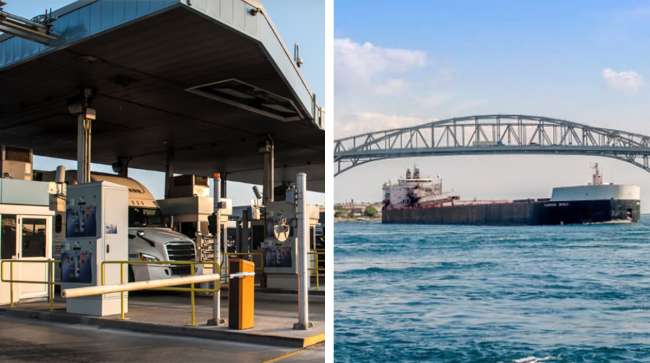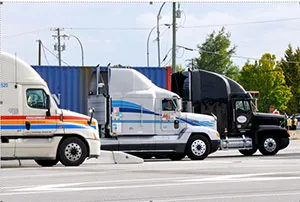Staff Reporter
Washington, Michigan Get Funds to Improve Border Crossings

[Stay on top of transportation news: Get TTNews in your inbox.]
Two projects to improve commerce at the U.S.-Canadian border in Michigan and Washington are ventures in 33 states receiving $94 million in a new federal program to use advanced technology to improve transportation.
The U.S. Department of Transportation has made its first awards from $100 million appropriated annually for fiscal years 2022-2026 in the new Strengthening Mobility and Revolutionizing Transportation (SMART) discretionary grant program under the bipartisan infrastructure law. The SMART program was created to help eligible public agencies pay for demonstration projects using high-tech systems to improve transportation efficiency and safety. Winning projects had to involve: coordinated automation, connected vehicles, delivery/logistics, innovative aviation, sensors, smart grid, systems integration or traffic signals.
Of 392 applications for the first round of SMART grants (seeking an average of $1.5 million per project) the DOT chose 59 projects.
“Every major advancement in the history of U.S. transportation has involved technological progress,” Transportation Secretary Pete Buttigieg noted March 21 when announcing fund recipients. “The investments we are making today are about fostering innovations that improve people’s day-to-day lives, making transportation safer, more reliable, more efficient and more sustainable.”

Pacific Highway truck staging area in Whatcom County, Wash. (Whatcom Council of Governments)
DOT noted that the first year of the SMART program was oversubscribed with $6 in applications for every $1 available from the government. Selected projects are eligible to apply for next-phase implementation grants.
Robert Hampshire, DOT’s chief science officer and deputy assistant secretary of research and technology, remarked, “We are thrilled to see the interest in SMART during its inaugural year. This shows the important role this new program can play in helping support state, local and tribal efforts to advance technology applications.”
One grant ($458,000) was awarded to Whatcom Council of Governments (WCOG), a cooperative forum on regional issues like transportation. It is composed of members from Washington state’s Whatcom County and its seven cities, the Port of Bellingham and the Lummi Nation. The county has four border crossings with British Columbia that together are called the Cascade Gateway, ranking among the busiest and most economically important crossings along the entire U.S.-Canadian border.
WCOG’s grant is for planning and a prototype of a bi-national public wait-time system at the U.S.-Canadian border in northern Washington.

Conroy
Hugh Conroy, WCOG planning director, told Transport Topics the grant will support coordinated planning by state, provincial and U.S.-Canadian border inspection agencies to determine the best way to update or replace aging regional systems with one to estimate and communicate real-time border wait-time information to travelers.
“The current systems at one time included some measures of truck-lineup wait times. It is our intention to explore how commercial vehicle wait times can be more robustly included, along with personal vehicle wait times, in a replacement system/set of systems,” Conroy said.
Although the project is in the initial phases, he theorized that a revamped system giving truckers better wait-time information at border crossings “could sometimes factor into dispatch decisions” regarding hours-of-service rules.
“It’s not entirely clear how cross-border drivers of loaded trucks would be able to use wait-time information to choose faster routes” if a nearby commercial crossing is worth diverting to for the shorter wait time, “but it’s possible that they could arrive at different ports of entry than has been preliminarily entered on entry documents and/or manifests,” he said.
The systems in use rely on a loop detector system estimating current wait times (the wait likely to be experienced by the next arriving vehicle). However, newer technologies predict actual wait times, using the actual wait of the last vehicle that left an inspection booth.

Mueller
In another SMART cross-border grant, Michigan Department of Transportation received $1.8 million to implement a proof of concept to predict arrival and processing times for truck-borne freight going over the Blue Water Bridge to the Port Huron port of entry to Canada.
“Currently, trucks carrying freight across the border can experience lengthy delays at peak times. This project will decrease pollution from idling vehicles and decrease supply chain costs,” said Michele Mueller, MDOT’s senior project manager for connected and automated vehicles. “In 2020, $71.5 billion in goods passed over the Blue Water Bridge, so the potential benefits to the environment, along with a reduction of transportation costs, are tremendous.”
A new system will support pre-clearance for freight shipments and minimize queuing and backups, while maintaining data and information security.
Want more news? Listen to today's daily briefing below or go here for more info:

